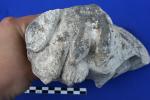
Description
- 1078
- Panther paw, fragment
- 3rd-4th c. AD
- White marble.
- L. 22 cm long, ht. 11 cm, w. 9.8 cm.
- The finished edge of the rocky base is preserved in front and at left; the fragment is broken away behind, leaving only the digits of the panther paw, with damage to the tips of the outer digits. The surface is unscarred, under a light grey-brown encrustation.
- The fragment preserves part of the right front paw of a large, life-sized feline, talons curled around the depicted sharp edge of faceted rock. Carving style is exuberant; the treatment emphasizes intricately shelving and splintered rock, and the flesh of the panther's digits swells in exaggerated fashion around the strongly marked bone. Especially notable is the strong furring, large tufts from which the talons barely emerge to view.
- There are few parallels for such tufting of joints and extremities of furred animals, although a tigress handle in inlaid silver from the Late Antique Hoxne Treasure shows a comparable exaggerated verism of hair and of swelling joints. If the principal figure of the group was Dionysus, he may have been over-life-sized. The date is not easy to determine; the expressionistic treatment suggests a terminus post quem of the late Antonine period.
- Dionysos and panther statues, see LIMC III 1986 sv Dionysus cat. 128b, 119a. - Hoxne silver tigress, Johns 2010, 30; http://www.britishmuseum.org/explore/highlights/highlight_objects/pe_prb/s/hoxne_hoard_silver_tigress.aspx.















![Download [view]](/villamagna/ark//skins/villamagna/images/results/download_sml.png)


